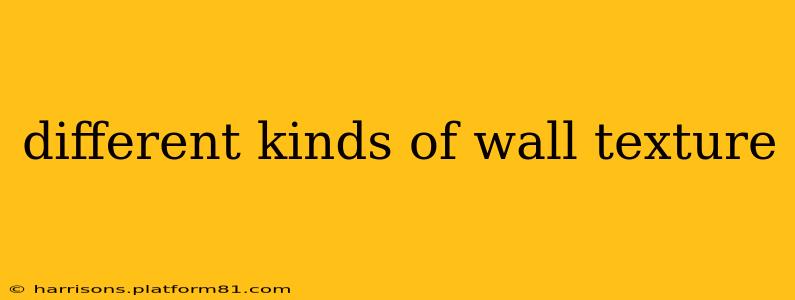Wall texture is more than just aesthetics; it plays a significant role in setting the mood and style of a room. From sleek minimalism to rustic charm, the right wall texture can dramatically transform a space. This comprehensive guide explores the diverse world of wall textures, helping you choose the perfect one for your home.
What are the Different Types of Wall Textures?
Numerous options exist, each offering unique visual and tactile qualities. We'll categorize them broadly for easier understanding:
1. Smooth Textures:
These create a clean, modern look, ideal for minimalist or contemporary designs. Examples include:
- Plaster: A classic choice, plaster offers a smooth, even finish when applied correctly. It can be painted in any color and is highly durable.
- Paint: The simplest method, paint itself can offer a smooth texture depending on the type and application. A high-gloss paint will create a reflective surface, while matte paints provide a softer finish.
- Wallpaper with a Smooth Finish: Many wallpapers boast a smooth surface, providing a clean look while offering diverse patterns and colors.
2. Lightly Textured Walls:
These offer a subtle variation in surface, adding visual interest without being overly dominant.
- Slightly Rough Plaster: A less meticulously smoothed plaster finish can provide a subtle texture.
- Venetian Plaster: This sophisticated technique creates a luminous, slightly textured surface with a marble-like effect. It's a high-end option adding a touch of luxury.
- Limewash: A traditional technique that leaves a slightly textured, breathable finish. It's known for its subtle, aged look and environmentally friendly nature.
3. Heavily Textured Walls:
These create a dramatic visual impact, often used as a statement piece.
- Stucco: A durable, exterior wall finish, but also used indoors to create a heavily textured, rustic look.
- Wood Paneling: Adds warmth and texture, with varied patterns and finishes available.
- Brick: A timeless choice offering a rugged, rustic texture. Can be painted or left exposed for a more industrial aesthetic.
- Stone: Similar to brick, but with more irregular shapes and sizes. Ideal for creating a natural, rustic or even luxurious feel depending on the type of stone used.
- Sand Finish: Provides a gritty, coarse texture, often seen in more informal settings.
4. Specialty Textures:
These options go beyond the typical and provide unique visual and tactile experiences.
- Exposed Aggregate: This technique exposes the aggregate (small stones, pebbles, etc.) in the concrete mix, giving it a unique, rough surface.
- Stamped Concrete: Creates patterns and textures on concrete surfaces, mimicking other materials like brick or stone.
- 3D Wall Panels: These panels add depth and dimension to the walls, creating striking visual effects. They come in a wide range of designs and materials.
How to Choose the Right Wall Texture for Your Home?
Consider these factors when selecting a wall texture:
- Room size: Heavily textured walls can make small rooms feel smaller, while smooth textures can make them feel more spacious.
- Lighting: The texture's appearance will be influenced by the amount and type of light in the room.
- Style: The wall texture should complement the overall style of your home décor.
- Maintenance: Some textures are easier to clean and maintain than others.
What are the Pros and Cons of Different Wall Textures?
The pros and cons vary greatly depending on the chosen material. For instance, smooth finishes like plaster are easy to clean but can show imperfections easily. Heavily textured walls like stucco offer durability and visual interest, but cleaning can be more challenging. Consider your lifestyle and preferences when making your decision.
What is the most durable wall texture?
Durability depends on the material. Stucco and brick are exceptionally durable, withstanding wear and tear better than many other options. However, even these require occasional maintenance.
Which wall texture is best for a small room?
Smooth textures are generally best for small rooms, as they help to make the space feel larger and more open. Avoid heavily textured walls in small rooms, as they can make them feel cramped and cluttered.
How do I add texture to my walls without painting?
Wallpaper, 3D wall panels, and installing wood paneling are excellent ways to add texture without resorting to paint.
Choosing the right wall texture is a crucial design decision, affecting both the visual appeal and the overall feel of your space. By considering the various options and factors outlined above, you can select a texture that perfectly complements your home’s style and your personal preferences.
